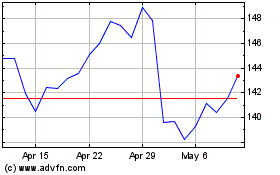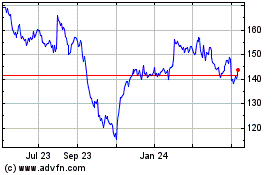Consumer-Goods Firms Shine in Financial Category -- WSJ
December 06 2017 - 3:02AM
Dow Jones News
P&G, Clorox and Colgate-Palmolive put their cash to good
use. But their markets are challenging.
By Ezequiel Minaya
This article is being republished as part of our daily
reproduction of WSJ.com articles that also appeared in the U.S.
print edition of The Wall Street Journal (December 6, 2017).
Consumer-goods companies may be under siege from slumping sales
and aggressive activist investors, but three of the industry's
stalwarts -- Procter & Gamble Co., Clorox Co. and
Colgate-Palmolive Co. -- placed among the top 20 in the
financial-strength category of the Drucker Institute's Management
Top 250 most effectively managed U.S. companies.
These companies excel at churning out profit and putting their
cash to good use. By squeezing reliable profits from toothpaste,
laundry detergent and housecleaning-product brands that date as far
back as a century, this trio of consumer-products giants is also
part of a select group of S&P 500 companies that have raised
dividends annually for 25 consecutive years or more.
The metrics the Drucker Institute used to assess financial
performance include return on assets, return on equity and return
on invested capital, common measures of how efficiently a company
makes money. Drucker also considered companies' market share and
profits, and the total return for investors in their shares.
P&G, Clorox and Colgate-Palmolive were among seven companies
that made the top 20 both in financial strength and overall. The
others were Apple Inc., the leader in financial strength and second
overall, chip maker Nvidia Corp., Alphabet Inc. and Accenture
PLC.
Challenging times
The consumer-products companies have been hard pressed to boost
sales growth while facing increased competition and shifting
consumer tastes. There are concerns over whether they can continue
their strong financial momentum, says Lawrence Crosby, chief
research scientist for the development of the Drucker rankings.
Among the common threads at the three companies: Each has a
chief financial officer who has been with the company at least a
quarter-century, with Colgate CFO Dennis Hickey serving the longest
tenure, at 40 years.
Those long terms of employment make the finance leaders at these
companies good at cost-cutting, says Peter Crist, chairman of
executive-search firm Crist|Kolder Associates. "They know how to
pull the levers," he says.
P&G in recent years has narrowed its focus, cutting back
from more than 100 brands to 65, in hopes of speeding revenue
growth and reversing market-share erosion, says finance chief Jon
Moeller.
The 180-year-old company, ranked No. 4 for financial strength by
Drucker, has cut some 20,000 jobs between 2012 and 2016, while
trimming $10 billion in costs. Company leaders have vowed to cut an
additional $10 billion by 2021, mostly by streamlining their supply
chain and bureaucracy, and focusing efforts on top brands.
"The strategy was put in place two or three years now," Mr.
Moeller says. "We want to be in categories that are used
daily."
Meanwhile, the company has grappled with a bruising proxy fight
with activist investor Nelson Peltz. Mr. Peltz argues that P&G,
the maker of Tide detergents, Pampers diapers and Gillette razors,
is burdened by excessive costs and bureaucracy and isn't moving
fast enough to boost sales and profit.
Adapting to change
Oakland, Calif.-based Clorox, 16th in Drucker's measure of
financial strength, has been able to adapt to changing market
dynamics with new or acquired products, such as its disinfecting
wipes and its Burt's Bees brand, helping it match up with smaller,
agile competitors, says Jason Gere, a consumer-products analyst at
KeyBanc Capital Markets.
The company's financial strength is reflected in its dividend
policy. Over the past four years, Clorox has returned $2 billion
through share buybacks and dividends, says CFO Stephen Robb. "We've
increased our dividend for 40 straight years," he says.
New York-based Colgate is 18th in financial strength (tied with
Boeing Co.), thanks in part to strong return on invested capital.
Slightly more than half of the company's cash is generated from
capital investments.
But Colgate's international reach has posed some challenges.
Most of the company's sales come from outside North America, and it
has seen its top line dented by currency woes.
Mr. Minaya is a reporter for CFO Journal at The Wall Street
Journal in New York. He can be reached at
ezequiel.minaya@wsj.com.
(END) Dow Jones Newswires
December 06, 2017 02:47 ET (07:47 GMT)
Copyright (c) 2017 Dow Jones & Company, Inc.
Clorox (NYSE:CLX)
Historical Stock Chart
From Apr 2024 to May 2024

Clorox (NYSE:CLX)
Historical Stock Chart
From May 2023 to May 2024
